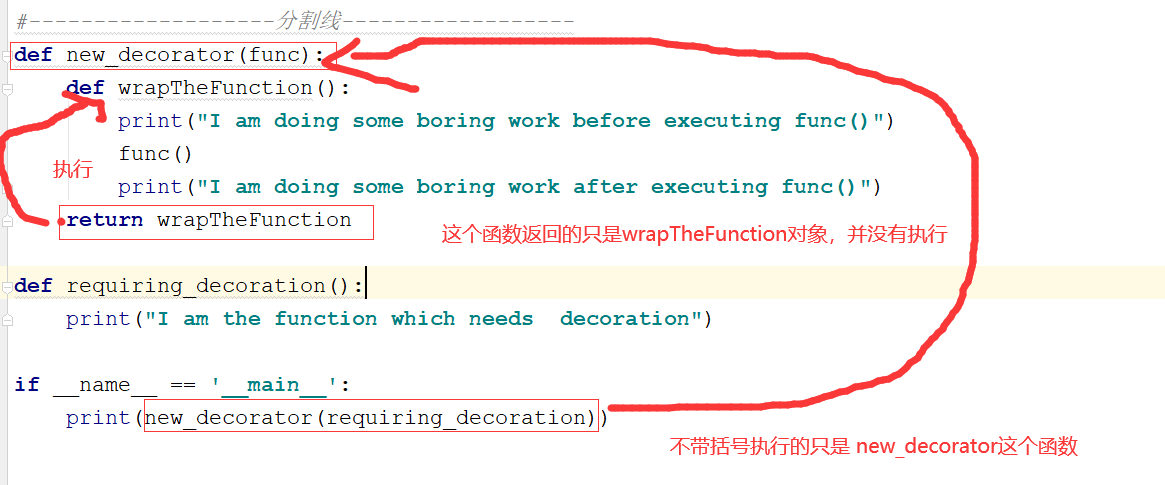一、简介
装饰器是是修改其它函数功能的函数;其意义是让其他函数在不修改任何代码的前提下增加额外功能
二、数据类型

首先我们来看一段简单的代码:
from types import MethodType,FunctionType class A(object): def f1(self): pass def f2(a, b): return a + b if __name__ == '__main__': a = A() print(type(a.f1)) #<class 'method'> print(type(f2)) #<class 'function'>
结论:不难看出,f1的类型是方法,f2的类型是函数;那有人会问了解这个有啥作用呢?其实了解这个有助于我们下面了解装饰器的原理
三、认识装饰器:

let's go... 我们来看一个案例:
def B(): print("now you are inside the B() function") def sing(): return "now you are in the sing() function" def eat(): return "now you are in the eat() function" def sleep(): return "now you are in the sleep() function" print(sing()) print(eat()) print(sleep())
#输出的结果为: now you are inside the B() function now you are in the sing() function now you are in the eat() function now you are in the sleep() function
结论:那现在我们知道了可以在函数中定义另外的函数。也就是说:我们可以创建嵌套的函数
我们再接着看一段代码,如何让函数作为参数传给另外一个函数的:
def A(): return "hi 小陈!" def doSomethingBeforeA(func): print("I am doing some boring work before executing A()") print(func()) #执行: doSomethingBeforeA(A)
#输出结果: I am doing some boring work before executing A() hi 小陈!
什么?你还没看懂,那我们再看一个案例:

from types import FunctionType def text(): return "Hello world!" def add_itali(func: FunctionType): def new_func(): #print("now you are in the new_func() function") return text() #返回text()函数 return new_func
#执行: print(type(add_itali(text))) print(add_itali(text)())
#输出结果: <class 'function'> Hello world!
难么现在你看懂了么?如果还是没懂,没关系我们再来看看下一段代码:
def new_decorator(func): def wrapTheFunction(): print("I am doing some boring work before executing func()") func() print("I am doing some boring work after executing func()") return wrapTheFunction def requiring_decoration(): print("I am the function which needs decoration")
#执行: requiring_decoration() #输出结果: I am the function which needs decoration
#执行: new_decorator(requiring_decoration)() #输出结果: I am doing some boring work before executing func() I am the function which needs decoration I am doing some boring work after executing func()
有人会有疑问,new_decorator(requiring_decoration)()为哈后面要加“()”呢去,请继续往下看:
#执行: print(new_decorator(requiring_decoration)) #输出结果: function new_decorator.<locals>.wrapTheFunction at 0x000001FC976BB620>
为什么会这样呢,请随我娓娓道来。。。

四、装饰器的优雅使用:

那么好,我们把上面代码再优化下,用装饰器常用的表达方式表示出来:
def new_decorator(func): def wrapTheFunction(): print("I am doing some boring work before executing func()") func() #被装饰的函数 print("I am doing some boring work after executing func()") return wrapTheFunction @new_decorator def requiring_decoration(): print("I am the function which needs decoration")
#执行: requiring_decoration() #输出结果: I am doing some boring work before executing func() I am the function which needs decoration I am doing some boring work after executing func()
老铁们,现在你们懂了么,没懂我们再来看一段代码:
#需求: <b><i> Hello World!</i></b> from types import FunctionType
def add_bold(func: FunctionType): def new_func(): return f"<b>{func()}</b>" return new_func def add_itali(func: FunctionType): def new_func(): return f"<i>{func()}</i>" return new_func @add_itali # 语法 @add_bold def text(): return "Hello world!"
#执行: print(text()) #输出结果: <i><b>Hello world!</b></i>
五、总结:

#语法:装饰器就是一个函数 def 装饰器名(func): def wrapper(*args, **kwargs): // 要做的装饰 ,,省略若干代码 result = func(*args,**kwargs) return result return wrapper